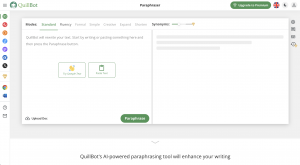People around the world are having a field day using AI to help them write books, content, guides, lesson plans, and more. However, many people are debating their job security as writers, whether AI-written text is plagiarism or not, and how it’s going to change the way we write.
AI tools are already changing the way we write – for the better. AI can automate many aspects of the writing process to save time and money, which you can spend on generating new content. And those who view it as a negative will most likely fall behind as more people adopt it in their workflow and become better and more efficient writers.
In this guide, we’ll discuss these issues and more so that you feel empowered to use AI to enhance your writing process.
What Is AI-Generated Content?
AI-generated content is any text (or image) produced by AI, such as ChatGPT and JasperAI. To use this software, you just ask a question or give a prompt, and the AI will produce a response. For example, using the chat function on ChatGPT, you can ask it to “write an article on how to grow houseplants,” and it will! Seems pretty cool… and scary.
As you can imagine, this has stirred up a lot of debate and concerns online, especially among professors and universities that now have another hurdle when it comes to enforcing academic integrity. Additionally, some writers are already claiming that online publications, such as The Revolutionist, which publishes AI-written content, are stealing their work.
Is Text Written by AI Plagiarized?
The biggest debate over AI-written content is whether it’s a form of plagiarism. Turnitin, an academic plagiarism and originality checker used by academics, has great insight into this issue.
In an interview with Jasper AI, Turnitin CEO Chris Caren stated that students using AI to write assignments is similar to contract cheating, in which a student pays a writing mill to write an assignment. Caren says it’s academic misconduct, although some academics disagree on this issue.
In terms of writers using AI to produce content, such as articles, blogs, or even entire books, the definitive answer is no, it’s not plagiarism. Carpenters use hammers to build furniture, but their maker’s mark doesn’t read “built by hammer.” The same rule applies for any person using AI to make their craft or life easier.
At the same time, writers who use AI to write entire pieces of content, with little to no modifications, must take responsibility for it once it’s published. Each AI software is trained in different sets of data and will provide varying information, even when given the same command.
Overall, writers using AI to write content should utilize plagiarism checkers to see the originality score of their writing before publishing. They should also be fact checking, editing, proofreading, and adding their personal touch to the content to avoid any potential plagiarism accusations.
Google’s Stance on AI-Generated Content
Regardless of your personal view on using AI-generated content, only one voice matters: Google. Google stated that any content written (by anyone or thing) with the purpose of manipulating their ranking systems violates their spam policy. Google rewards original, high-quality content that reflects E-E-A-T (expertise, experience, authoritativeness, and trustworthiness) qualities.
So, if you’re looking to incorporate AI into your writing process, go for it! It’s a great tool that can streamline your writing process and help you produce higher-quality work.
How to Use AI in Your Writing Process
We are strong proponents of writers using AI to streamline their writing process. The technology is here to stay. Individuals or businesses that don’t incorporate AI into their practices are missing out on its great benefits and could get left behind.

Here are some ways to incorporate AI into your writing process:
- Brainstorming: AI is great for helping generate new ideas to write about. For example, you can ask ChatGPT any question to get ideas about what people are looking to know more about.
- Researching: Once you’ve landed on a topic, use AI to learn more about it. It can cut down on the time you spend researching and reading large amounts of information. Of course, always fact check information that AI writing software provides and cite credible, reliable sources in your writing.
- Outlining: Every article or post needs an outline, but they can be tedious to write. If you already have an idea of what you want to write and general information you plan to discuss, plug it into any of the available AI writing programs, and they’ll generate an outline for you.
- Writing: While we don’t support using AI to write entire articles from start to finish, it can be helpful to get started on the writing process. You can have any program write a section for you and then go back to fine tune and enhance it. Make sure the text is error-free and factually accurate if you plan to use AI to write for you.
- Editing and proofreading: Editing and proofreading are arguably the most important steps in the writing process. Having error-free writing will enhance your SEO and credibility online and contribute to the overall quality of your writing. Using AI software, such as Wordtune or the Hemingway app, can help you identify errors while proofreading and editing your own work.
Other Ways AI Can Improve Your Content
- SEO and keyword analysis: If you need to write SEO content, then AI is your new best friend. You can have AI write SEO-focused content for you to make sure your content ranks high on SERPs. Of course, avoid keyword stuffing and make sure your content follows Google’s E-E-A-T guidelines to avoid being flagged as spam.
- Fine tune your tone and style: Most AI writing software has features to adjust the tone of a text. This can be helpful to ensure a consistent tone or style of writing that aligns with your brand voice.
- Repurpose content: If you already have an article or blog post on a topic, you can have AI summarize it for a social media post or turn it into an email to quickly update customers about new products or services. The options are endless for repurposing content with AI.
Considerations For Using AI Writing Tools
Should You Use AI Writing Tools to Write Content?
The short answer is no, you shouldn’t use AI to write for you from start to finish. AI is still in its infancy when it comes to writing content. It can’t replace authors, content writers, or copywriters because it lacks the one thing that makes us unique: our emotions.
It can’t (and probably never will) create content using sarcasm, humor, or empathy. It can’t use the power of a personal story to evoke emotion in readers. These are features of good writing and good writers, which AI cannot effectively produce.
If you use AI to write content, always be sure to go in and add a personal touch to the text. This will enhance the overall quality, tone, and emotional appeal of the piece. Additionally, it ensures that the content reflects an original thought rather than reproducing information already available online.
Make sure to check that your AI-generated content has a human tone by using AI-detection software and checklist.
Should You Fact Check Information From AI?
Yes. AI generates information and text from websites and social media, which are notorious for bias, misusing data, or even outrightly spreading false information. This is most likely the biggest flaw of the AI writing software available.
While using AI to research or learn more about a topic is a great way to save time, you should always fact check any data it gives you to maintain your reputation as a trustable and credible source.
Additionally, make sure that any information you get from AI is backed by a credible source. Be sure to investigate the source yourself, check for any bias, and hyperlink to it in your content. This will improve your SEO and contribute to Google’s E-E-A-T requirements.
Should You Edit and Proofread AI-generated Content?
Yes. AI isn’t perfect, and it generates text that’s syntactically and grammatically incorrect quite often. All content, written by a person or AI, should be edited and proofread before publication.
Take, for example, a blog post introduction from GetGenie, an AI writing plugin for WordPress. It included random capitalization, a stray quotation mark, awkward phrasing (such as “a super-advanced level unique”), and four uses of “unique” in as many sentences. It’s a great example of why editing and proofreading AI-generated content is necessary.
AI Content Writing Tools
Now that we’ve covered how to responsibly and effectively use AI in your writing process, let’s look at some of the available AI writing tools you can get started with.
ChatGPT

No AI writing tool list would be complete without ChatGPT. It broke the record for the fastest-growing consumer application in history after it reached 100 million users in just two months. The program is designed to “chat” with you, answering questions, writing and summarizing text, providing translations, and much more.
ChatGPT is specifically optimized for conversational language and can generate coherent and contextually relevant responses to a wide range of questions and prompts. It’s trained on a massive corpus of text from the internet, which allows it to understand natural language patterns and nuances.
Pros:
- Natural language generation: ChatGPT is capable of generating natural-sounding responses to a wide range of prompts, which makes it ideal for conversational applications.
- Wide range of potential applications: ChatGPT can be fine-tuned for a variety of applications, including chatbots, language translation, and content creation.
- Saves time and resources: ChatGPT can automate various language-related tasks, which can save time and resources for businesses and individuals.
Cons:
- Potential biases: Language models are trained on massive datasets, which can contain biases and inaccuracies reflected in the model’s responses.
- Limited understanding: While ChatGPT can generate natural-sounding responses, it may not fully understand the context or implications of its responses.
Quillbot

Quillbot is an AI-powered writing tool that uses natural language processing (NLP) technology to rephrase, paraphrase, and summarize text. With Quillbot, users can input a piece of text and get multiple variations of it that maintain the original meaning but use different phrasing, sentence structures, and word choices. This can be helpful for various purposes, such as avoiding plagiarism, improving readability, or generating new ideas.
Quillbot offers several modes, including standard, fluency, creative, and concise, each with different goals and levels of complexity. The tool also provides advanced features like grammar and plagiarism checks, a contextual thesaurus, and tone adjustments.
Overall, Quillbot aims to assist writers, students, educators, and anyone who needs to communicate effectively by providing a fast and reliable way to enhance their written content.
Pros:
- Saves time and effort: Quillbot can help users quickly generate multiple variations of a piece of text, which can save a significant amount of time compared with manually rephrasing or paraphrasing.
- Improves writing quality: Quillbot’s advanced features like grammar and plagiarism checks can help improve the quality of the writing by ensuring it’s free of errors and plagiarism.
- Enhances creativity: The tool’s creative mode can help users generate new ideas and phrasing, which can be helpful when trying to come up with fresh content.
- User friendly: Quillbot has a simple and easy-to-use interface, making it accessible to users of all technical proficiency levels.
Cons:
- Not always accurate: While Quillbot’s AI is advanced, it’s not always accurate in its rephrasing and summarizing. Users still need to manually review and edit the output to ensure it accurately reflects their intended meaning.
- Limited vocabulary: Quillbot’s vocabulary is not as extensive as a human’s, and it may struggle with complex or technical language.
- Expensive: Quillbot’s premium features can be costly, which may not be affordable for everyone.
Article Forge

Article Forge is an AI content creation tool that uses NLP technology to generate high-quality articles on any given topic. With Article Forge, users can input a topic or keyword, and the tool will generate a unique, SEO-optimized article in just a few minutes. The tool uses machine learning algorithms to analyze and understand the context of the topic and then generate content that’s both informative and engaging.
Article Forge offers several customization options, including tone, length, and formatting, allowing users to tailor the generated content to their specific needs. The tool can also automatically add images and videos to the article, further enhancing its visual appeal.
Pros:
- Saves time: Article Forge can generate unique, SEO-optimized articles in just a few minutes, saving content creators time and effort.
- Scalability: The tool can generate large volumes of content quickly and efficiently, making it ideal for businesses and individuals who need to produce a lot of content.
- Customization: Article Forge offers several customization options, allowing users to tailor the generated content to their specific needs.
- Cost-effective: Article Forge is a cost-effective solution for generating high-quality content.
Cons:
- Limited creativity: The content generated by Article Forge is based on algorithms and may lack the creativity and nuance of content from human writers.
- Limited accuracy: While Article Forge can generate high-quality content, it may not always be accurate or comprehensive.
Conclusion
AI writing tools are already revolutionizing how we write. With the right application and ethical usage, they can save time by automating aspects of the writing process, help us create more informative and engaging content, and assist with tedious tasks, such as editing and proofreading.
There are many AI writing tools on the market, each with its own pros and cons and targeted for different writing purposes. Be sure to try out different ones and see which one works best for you and your needs. And be sure to fact check all information, add your personal touch, and edit and proofread everything before publishing.
If you’re looking for an AI-editing specialist to check your AI-written content and give it a human finish, you can also find out more about our AI-generated content editing services.


